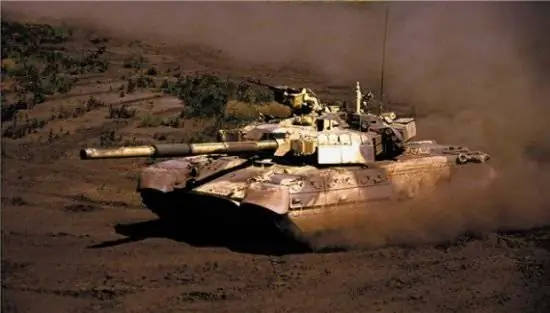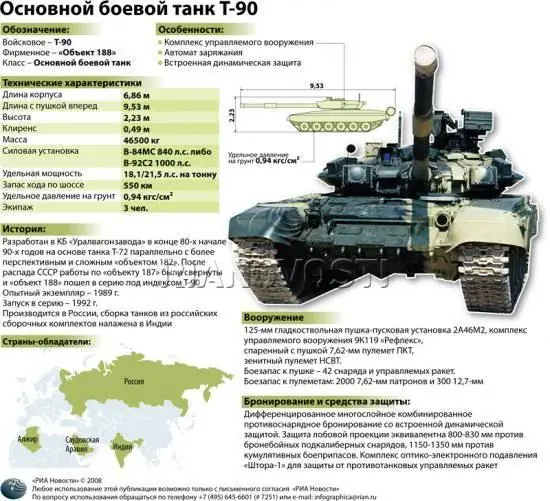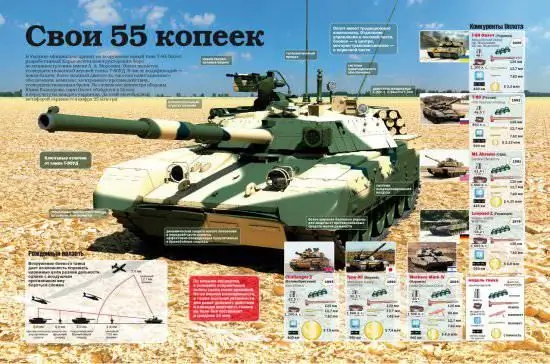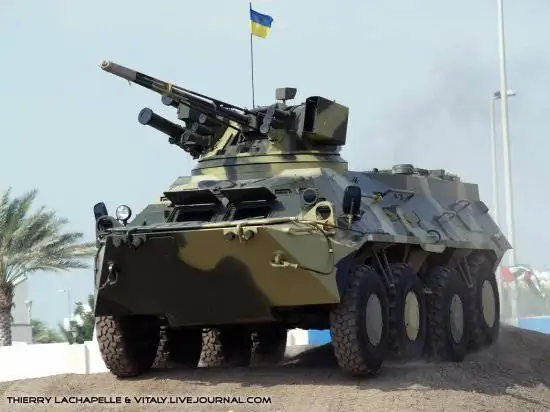- Author Matthew Elmers [email protected].
- Public 2023-12-16 21:49.
- Last modified 2025-01-24 09:17.

As reported by the Open Society Security Academy, Khvilya, Ukraine. The command of the land forces of Thailand has announced a tender for the purchase of 200 tanks to modernize the existing military equipment. Three countries applied for participation in the tender: Ukraine with the new Oplot tank, Russia with the modernized T-90 and Germany with the improved version of the Leopard 2A4. The Thai government considered all the proposals and eventually declared Ukraine the winner, and now 200 Kharkiv tanks will be assembled and handed over to Bangkok. This news was perceived in Russia as a national insult, while in Ukraine, on the contrary, with obvious satisfaction. For Kiev, this is a great chance to rehabilitate itself for the scandalous story associated with the delay in the delivery of armored vehicles to Iraq on the basis of the signed contract.
It should be noted that both Russia and Ukraine learned about the victory of Ukrainian Oplots in Thailand's tender from one source - the Thai English-language newspaper Bangkok Post. It is, of course, Thailand's largest state-level daily newspaper, but certainly not the official mouthpiece of the government or the country's defense ministry. If you look at this situation from the outside, you get the impression that with such a leak of information into the Bangkok Post newspaper, the organizers of the tender were probing the ground on the reaction of all participants to the victory of Ukraine.
The question remains unclear - for what purpose was this done? Even more strange is the fact that, a few days after the publication of the note in a Thai newspaper and against the general background of the uproar, neither Thailand nor Ukraine has made any comments or official statements. In any case, at the moment it only remains to wait for the official announcement of the tender results. But even now, a number of questions arise regarding both the further promotion of modern Ukrainian armored vehicles and weapons on the international market, and the growing confrontation of the interests of the Ukrainian military-industrial complex with Russian colleagues.
It must be admitted that in this respect the issue does not seem insignificant or idle: as you know, only in the last year has Russia made significant efforts to "integrate" the most powerful Ukrainian defense enterprises into the Russian defense industry. So, in particular, today the issue of the future of the Ukrainian shipbuilding and aircraft industry has actually been resolved; in the near future, the process of integration of individual Ukrainian enterprises representing the middle rank into the corresponding production facilities in Russia should be carried out. At the same time, for quite understandable reasons, the marketing functions, that is, the creation and management of existing mechanisms for promoting products to the world arms markets, are taken over by the Russians, which removes the issue of any competition from the current agenda.
But all agreements between Russia and Ukraine do not apply to tank production. Today, this sector is the most powerful in the state's defense industry, which does not have any "integration" processes at the Ukrainian-Russian level, and which acts as an individual player from Ukraine on the international arms market. At the same time, in March 2011 at the main Ukrainian tank building enterprise - SE Malyshev Plant (Kharkov) - there was a change of leadership. It was Vladimir Mazin, who previously headed the Kiev plant for the repair of armored vehicles. It is not clear what meaning has been invested in the next change of the director of the state enterprise, and what state tasks have been formulated for him by the current Ukrainian government - obviously, this will become clear in the near future. At the same time, Ukrainian tank builders are gradually promoting their commercial interests in the international market on an individual basis.
So whose tank is better?
Immediately after the news that Ukraine had won the victory, Russian experts began to actively discuss the question: why did Russia lose? Is it a tactical defeat or is it a growing trend? And what are the general international prospects for the Russian T-90 tank, today not only the best, but actually the only modern one that the Russian Federation offers?
The main reproaches were immediately addressed to Colonel-General Alexander Postnikov, Commander-in-Chief of the Russian Ground Forces. Indeed, it was hard not to notice that the winner of the Thai tender became known literally two weeks after the famous scandalous statement by the Russian commander-in-chief about the T-90, which was adopted by the Russian Armed Forces in 1992. In Russia, in this regard, there was a considerable scandal: Postnikov in mid-March of this year sharply criticized the T-90 tank, which, according to him, is nothing new and even less modern, and “in reality is the 17th modification of the popular Soviet T-72, which has been produced since 1973 . The commander-in-chief said that at the moment the cost of the T-90 is 118 million rubles per tank. “It would have been easier for us to buy three Leopards for this money,” he said. These words, spoken in the heat of the moment, are now remembered by Colonel-General Postnikov as allegedly the main culprit in the loss of the T-90.

Indeed, on the one hand, such statements by the general of the Russian army could have influenced the final position of Thailand when making a decision. But on the other hand, the T-90 tank has been criticized for a long time and by many. Moreover, not only experts but also, oddly enough, the manufacturers of this machine themselves are critical of its "novelty". You can recall how during the Russian Expo Arms-2009 arms exhibition the head of the T-90 corporation Uralvagonzavod (by the way - monopolistically) Oleg Sienko said: “If we do not produce new products in the next five years, then we can safely write “carts” or “carts” on Uralvagonzavod products - this technique will not be needed at all … We agree that today our cars are becoming obsolete, and this period is calculated not in years, but in days. " If we take these expressions into account, then, with the same success, one can blame Mr. Oleg Sienko for losing 2011: his words were spoken more than two years ago, and which state will buy a combat vehicle today, which in three years may well become a "cart" personal opinion of the manufacturer?
The second "reason" for the loss, which is cited in Russia, is the case of Viktor Bout, a Russian arms dealer who was arrested in the Thai capital of Bangkok in March 2008 on charges brought against him by the United States. The main point of the charge was the illegal supply of weapons to a terrorist group. For two years, Bout was in a Thai prison, and despite the fact that, according to two court decisions, the detainee's guilt was not proven. For these actions in relation to its citizen, Russia spoke out with harsh criticism of the official Bangkok. According to Russian experts, this could also affect Thailand's choice of Ukrainian tanks to the detriment of the Russian Federation in the tender. Here, in this case, we are talking about big politics, and it is obvious that it is difficult to judge the truth of this reason, although this version also has the right to discussion and life.
Without delving into political showdowns, Russian experts, as expected, did not do without concrete slinging of Ukrainian military products with mud. So, for example, Colonel-General Sergei Maev, the former chief of the armored armament department of the Russian Ministry of Defense, said. that the tank "Oplot" is just "a Ukrainian significantly deteriorated copy of the Russian T-90". But, also according to the already established tradition, such opinions are not supported by anything concrete.
Of course, you can compare the individual technical characteristics of the two cars, and already at this level they are losing for the Russians (for example, the T-90 is equipped with a V-92S2 tank diesel engine with a capacity of 1000 hp, the Oplot has a multi-fuel six-cylinder two-stroke diesel 6TD engine 1200 hp). But in the Russian expert community, in episodes with military equipment, as a rule, they are in no hurry to follow this path in deciding which of the machines is "better". The main indicator may be a certain experience of using a combat vehicle in real armed conflicts, but, as a rule, a lot depends on other factors here too. Therefore, it is not so easy to determine which of the cars is better.

However, the indisputable fact is that both the Russian T-90 and the Ukrainian "Oplot" have a common design and technological background. In particular, the "ancestor" of both is the Soviet T-64, which was developed in Ukraine, in Kharkov, back in the early 60s under the direction of A. A. Morozov and became a kind of ancestor of a new generation of modern Soviet battle tanks. When creating the tank, the designers implemented a truly revolutionary design solution for that time. In particular, an automatic loader was adopted for the first time in the world on the T-64 tank, which made it possible to reduce the vehicle's crew from four to three people. Other radical improvements, undoubtedly, were: protection against weapons of mass destruction, complex combined multilayer protection, a new original layout in the engine compartment, etc. According to historians, subsequently the T-64 tank became quite reasonably considered the most important milestone in the further history of tank building of the USSR, since all subsequent tanks of the "T" series, including the T-72 and its modifications, the Russian T-90 and the Ukrainian T-84, were developed on the basis of the concepts that were originally introduced into the design of the T-64 tank.
Speaking about the possible reasons for Bangkok's preference for the Ukrainian machine, it is impossible not to note that today Kiev is quite productively working with Thailand in the sphere of supplying weapons for the ground forces.
As you know, in 2010, the Ministry of Defense of Thailand announced its intention to spend unspent funds from part of the military budget on the purchase of 121 Ukrainian armored personnel carriers, for which $ 142.5 million was initially allocated. Prior to that, in 2007, Thailand had already purchased from Ukraine 96 armored personnel carriers of the BTR-3E1 model for $ 130 million, but problems arose with the receipt of the vehicles ordered under the contract. So, according to the Ministry of Defense of Ukraine, the delay in the delivery of armored personnel carriers was due to the fact that Germany refused to supply components to Ukraine. Interestingly, the Ministry of Defense of Thailand then explained that despite all the problems with the implementation of the specified contract, the deal remains and, first of all, this is due to the cheapness of Ukrainian armored personnel carriers. In September 2010, Thailand still received the first batch of BTR-3E1 armored personnel carriers from Ukraine. At the same time, a statement was made that in addition to the armored personnel carriers themselves, Bangkok will also receive warranty service for three years, the necessary spare parts, and additional equipment.

Considering all of the above, if Ukrainian tanks go to Thailand, this can definitely be considered only a continuation of the intensified military-technical cooperation in relations between the two states. And in this regard, Thailand is a truly promising buyer. It may be recalled that at one time, Thailand was armed by the United States, considering it one of its main allies in the region. During the 70s and 80s. Thailand, with the active support of the United States, implemented the second comprehensive program of modern rearmament of the aviation, navy and army, and in the mid-90s - already the third, which was a complete reform and re-equipment. So, the United States provided comprehensive assistance in the supply of the most modern types of weapons and equipping the own state-owned Thai enterprises for the production of ammunition and weapons, replacing outdated weapons with modern models, training military specialists at the first stage, and then on the formed base of Thailand's own academies. As a result, the army of this state in the ground forces for 2010 had 333 main battle tanks, 515 light tanks, more than 32 armored personnel carriers, 950 armored personnel carriers. It is this morally obsolete armored "economy" that Bangkok is currently striving to replace with modern models. And it should be admitted that these are promising contracts.
One more question remains unclear. The delivery of Ukrainian armored personnel carriers to Thailand was accompanied by sharp criticism of Ukraine, and primarily from Russia, on the fact that in September of the same 2010 Cambodia, which has difficult relations with Thailand, received a batch of one hundred Ukrainian armored personnel carriers and tanks. The purchased armored vehicles arrived at the port of Cambodia Sihanoukville, but what kind of combat vehicles Ukraine supplied was not specified. The main criticism of the Ukrainian supplies was that the Cambodian government is currently implementing a program for the complete modernization of weapons, thereby increasing its military potential. Analysts say this is due to a possible resumption of conflict with neighboring Thailand over the disputed territories adjacent to the Preah Vihea Hindu temple. On the border, both sides have deployed their military units, between which armed clashes periodically occur.
The criticism, which consists in the Ukrainian supply of military equipment to the two sides of an explicit or possible conflict, can be answered simply and very accurately. Indeed, the existing UN Code of Conduct for Exporters of Military Equipment and Arms recommends refusing to supply arms and military equipment to zones in which conflicts exist or are possible. But at the same time, if we take into account the demand for weapons, primarily in such territories, the absolute majority of the world's leading arms suppliers sell weapons and military equipment without much moral hesitation. And the question of their responsibility, incl. Russia, by and large, is not particularly worried. Therefore, Ukraine does not need to play in chastity and take into account such criticism, and even more so from losing competitors.
It can be added that Russia should not yet make a big tragedy out of the victory won by Ukrainian tank builders in Thailand. After all, Russia itself, according to TSAMTO, only in recent years in the ranking of world suppliers of new MBTs in terms of quantitative ratio, with a large margin from other competitors, takes the first place. In 2006-2009. Russia exported 488 MBTs with a total value of $ 1.57 billion. In 2010-2013. the volume of export supplies, taking into account already confirmed contracts, as well as statements of intent to conclude contracts for direct supplies and licensed programs, may amount to $ 2.75 billion. Considering all this, it is safe to say that Moscow has no particular cause for concern.






